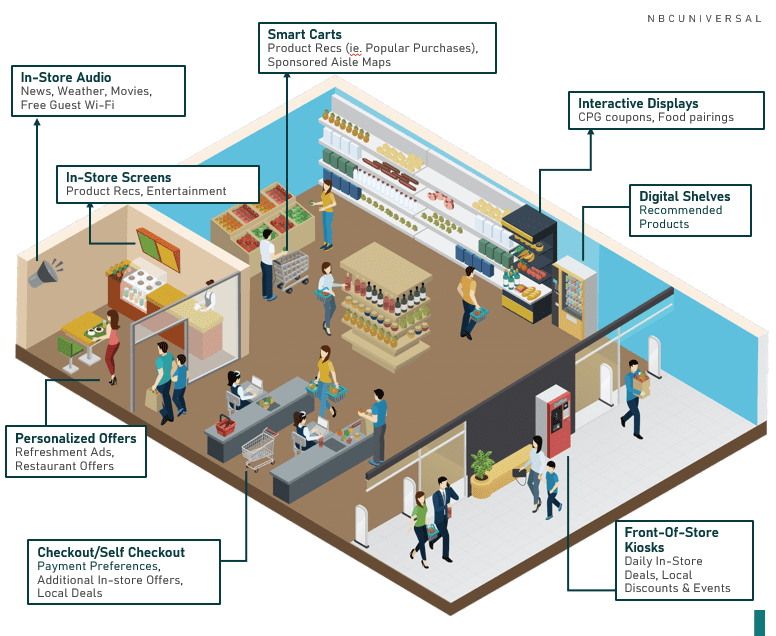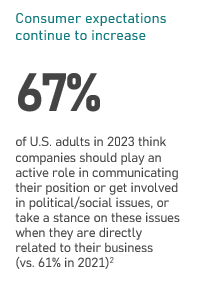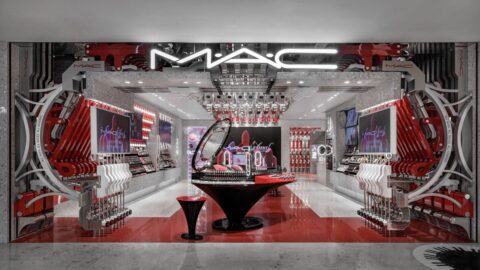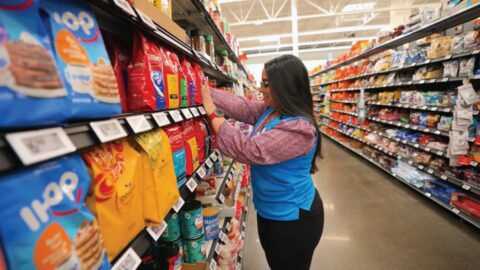As one of the largest media and entertainment companies in the world, NBCUniversal is also one of the biggest vehicles for brands to connect with consumers. Gina Reduto leads NBCU’s client strategy team, whose job it is to consult with advertisers on where and how to share their message for maximum impact. To do this, Reduto and her team immerse themselves in the industries they serve — and one of the largest is retail.
“Competition is crazier than ever in the retail category, and really across advertising in general,” said Reduto, SVP of Client Strategy at NBCU in an interview with Retail TouchPoints. “Just look at the pace at which new brands are entering the marketplace — 35% of advertisers today didn’t even exist three years ago. We’re constantly working with retailers to help them build their brand, knowing that there’s this incredible amount of competition. Consumers have so much choice, and brands more than ever need to show up in a way that’s relevant.”
To understand how best to do that, NBCU conducts regular research into industry trends, consumer behavior, insights from partners and more that it consolidates annually into a Retail Insights Report. This year’s report, which NBCU has shared first exclusively with Retail TouchPoints, highlights a world in flux and a consumer seeking connection.
The good news is that “even though the consumer has an incredible amount of choice, there’s also a ton of opportunity to make it really easy for them to choose your brand,” said Reduto. “It all goes back to understanding them and their mindset and then making it super easy for them by leveraging data, leveraging targeting, leveraging commerce. We’re all overwhelmed by the amount of choice, but if you make it easy and you reflect their desires in your creative, then it can be a win-win for the retailer and the consumer.”
Here are three of the biggest areas of challenge and opportunity that brands should prepare for in the coming months and years:
1. Continued Skittishness in the Market (and in Consumer Behavior)
Solution: Make Friends with Your Fans
Over the past year retailers have faced mixed cues from consumers, with “revenge spending” and spending on experiences increasing at the same time that high inflation drove consumers to become more discerning and frugal in other areas.
“Is the consumer going to continue to splurge and spend the way they’ve been spending, or with student debt coming back and the ongoing idea of a potential recession, are consumers going to pull back?” said Reduto. “How can retailers immunize themselves against all this potential skittishness in the marketplace? That’s where what we home in on is this idea that personalization and building almost a friendship with your consumer can help protect you against whatever happens in the broader marketplace.”
This idea of brand-consumer friendship marks the latest stage of what NBCU sees as the evolution of brand building. Originally brands were centered on product; that evolved and expanded to include a larger sense of a lifestyle or belief. And now brands are more frequently going beyond lifestyle and looking to build community. NBCU predicts that this evolution will continue further, from community into a deeper form of connection, a friendship, driven by personalization, one-to-one interactions and ongoing support.
“It’s this idea that brands really support you,” explained Adam Daniele, VP of Client Strategy at NBCUniversal Media in an interview with Retail TouchPoints. “They support your beliefs, and they’re offering recommendations and finding ways to engage with consumers that can even go beyond their category. For example, we see this in luxury, with brands offering suggestions on what songs to listen to or what movies to watch based on what their brand stands for and what your interests might be as a consumer who supports their brand. It’s about a much more personal relationship than even community.”
2. Personalization is More Important Than Ever
Solution: Leverage Data to Know Your Consumer
Offering consumers this level of personalized connection and support is enabled (and perhaps in some ways even being driven) by technological advancements that have made it possible to understand and engage with consumers one-to-one, at scale. “Technology and some of the advancements in commerce are helping retailers deliver against this idea, and retail media networks are actually a huge component of that,” said Reduto. “If you think about the quality of retailers’ first-party data and their ability to understand not only a consumer’s online behavior, but how that consumer also acts in-store, and then close the loop in terms of the actual end point and what the sale looked like — next-level personalization like that wasn’t possible three to five years ago.”
It is possible now though, and retailers need to use every resource at their disposal to understand their customers so they can cut through the noise. “Oftentimes we conflate personalization with relevance,” said Reduto. “Relevance involves demographic or psychographic targeting or attributes, but personalization is a true understanding of where the consumer is within their journey, what is most important to them and responding accordingly. Not every consumer prioritizes the same issues or looks at things through the same lens, so having that deep understanding really enables you to deliver on what is most important to them.”
And the rise of retail media is, in part, enabling this. Brands are projected to increase their retail media ad spend by 20% this year. For retailers, it’s hard to hear that and not see opportunity in the store, considering that retailers’ in-store audiences are still 70% larger than their digital audiences on average, according to Insider Intelligence.

Retailers already are working to offer more personalized in-store shopping experiences, with audio and screen-based content as well as smart shopping carts, interactive displays and digital shelves. “As data gets more sophisticated and technology improves, we’re really interested to see how video in stores plays out,” said Daniele. “This is an opportunity for brands to really tell their story, not just through point-of-sale and endcap activations, but to really get some storytelling in there as well and creatively engage with consumers.”
The biggest challenge will likely be similar to what brands face online — finding the right balance between personalization and privacy.
“[Retailers will need to take] what they learn online and play it out in-store,” said Reduto. “Think about how successful content and commerce have been together online — it’s about melding these different worlds and collapsing the purchase funnel in a way that hasn’t been possible before. But it’s a learning process, and a lot of what we’re talking about in terms of the store is still hypothesis. Retailers will have to test and learn to find the right balance of relevant and interesting, as opposed to intrusive and annoying.”
3. Business Needs Continue to Conflict with Consumer Wants
Solution: Be Transparent
The boom days of the pandemic — when stimulus money was flowing freely and cooped-up consumers were filling their time shopping online — are now well behind us, and this year has seen a renewed focus on profitability in retail. But current market conditions are making that difficult. Inflation and other economic pressures are driving consumers to make more price- and promotion-driven purchase decisions, with McKinsey reporting that 80% of consumers are trading down in their brand choices. Case in point, private label food sales jumped 8.2% in the first half of 2023, according to Circana.
Put that in context with other recent trends — the growing problem of retail shrink, online returns continuing to rise and the margin challenges of trendy consumer services like resale, for example — and NBCU’s conclusion is that the consumer experience is set to change, not because they want it to, but because retailers need it to in order to maintain the health of their business. This is already happening, with some retailers choosing to add friction to the shopping experience by locking up products and others choosing to begin charging for returns, for example.
Common wisdom holds that the customer is always right, but retailers are increasingly going against that to combat these pressures. And similar headwinds can be seen in the area of purpose-driven initiatives. As NBCU put it: “The discourse between consumers and brands has been intensifying, with more brands facing controversy after running purpose-driven efforts.” More and more consumers are choosing to shop with brands that take a stand and generate action on societal issues, but at the same time some of the most vocal brands have found themselves under fire for their efforts.
So what’s a brand to do amid these competing needs? NBCU’s advice is to stay the course and take the long view. For example, while purpose-driven strategies might raise the ire of some groups in the short term, the long-term impacts of standing for a cause that a company truly believes in are shown to be largely beneficial to both customer loyalty and employee retention. Not only that, but NBCU cites research from Kantar that found that not engaging in causes relevant to your customers, employees and shareholders could actually cost brands up to $5.4 trillion in lost revenues.

Across all of these customer-business conflicts, Daniele advises transparency as the gold standard: “Being transparent [is the best solution] in regard to a lot of these things,” he said. “As long as you’re being open and honest with consumers about your strategy and process, what you’ve accomplished and what you still have to do, consumers tend to respect that.”
There’s no denying that the advertising landscape is more complicated for brands than perhaps ever before, but within all that nuance lies a lot of opportunity as well. “More than ever, given all the competition out there, people just want inspiration,” said Daniele. “It’s about finding creative ways to do that, whether it’s through storytelling or commerce content. Make it easy for consumers to find out about your brand as quickly and seamlessly as possible.”
















